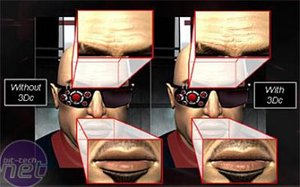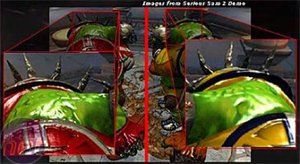Let's have a look at the features of the RV410 architecture.
<ul><li>SmoothVision HD</li><ul><li>3Dc Normal Map Compression</li><ul> <li>High quality 4-to-1 compression technique</li> <li>More realistic games</li> </ul> <li>up to 6x Multi-Sampling Anti-Aliasing with programmable sample patterns and colour buffer compression</li> <li>Temporal Anti-Aliasing</li> <li>6-to-1 loss less colour compression at all resolutions</li> <li>up to 16x Anisotropic Filtering</li> </ul>
<li>SmartShader HD</li> <ul> <li>Full support for DirectX 9.0</li> <li>Vertex Shader 2.0 support</li> <li>DirectX 9.0 Extended Pixel Shader support (SM2.0b)</li> <li>Multiple render target support</li> <li>Facing register for two-sided lighting</li> <li>Support for 128-bit, 64-bit and 32-bit per pixel floating point colour formats</li> <li>Complete feature set is also supported in OpenGL with the use of extensions</li> </ul>
<li>VideoShader HD</li> <ul> <li>Seamless integration of pixel shaders with video using the FullStream video de-blocking technology</li> <li>VideoSoap noise removal filtering for captured video</li> <li>YPrPb component output</li> <li>Complements PCI-Express bus for high performance High-Definition video editing and composition</li> <li>MPEG 1, 2, 4 encode and decode acceleration</li> <li>WMV9 and WMV10 decode acceleration</li> <li>Adaptive per-pixel de-interlacing and frame rate conversion</li> </ul>
<li>HyperZ HD</li> <ul> <li>3-level Hierarchical Z-Buffer with Early Z Test</li> <li>Loss less Z-Buffer Compression (up to 48-to-1)</li> <li>Fast Z-Buffer Clear</li> <li>Z Cache optimised for shadow rendering</li> <li>Optimised for performance at high display resolutions, including widescreen HDTV resolutions</li> </ul></ul>
3Dc - Compression
Nowadays, all graphics boards make use of texture compression technology in one form or another. Much like when you're compressing images in Photoshop for web use, texture compression is used to enhance performance with the focus on speed. In graphics technology, texture compression isn't just used to enhance the frame rate in a particular game title, it's also used to enable higher-resolution textures to be used, which essentially means that you can expect to see a higher level of detail in characters and environments. The smaller the memory footprint that is required to store textures, the less memory bandwidth is required to render the textures in game. However, there is a point where over-compression causes artefacts and image degradation; this is where 3Dc compression technology comes in.

3Dc is a new compression technology that was introduced back at the launch of the X800 series on May 4th. It is designed to bring out fine details in supported game titles, while minimizing frame buffer usage - 3Dc is the first compression technique that is optimised to work with normal maps. Normal maps are a mapping technique that allows for fine per-pixel control over how light is reflected off a textured surface, whether the surface is a characters' face or a wall, or indeed any other surface. There's up to a 4-to-1 compression ratio available when using 3Dc, which means that game designers can add up to 4 times the detail without impacting either the frame buffer requirement or the projected frame rates.

Memory bandwidth is of great importance in this era of graphics technology, where there's an increasing requirement for a combination of increased performance and greater image quality. Using a compression technology, such as 3Dc, to reduce the frame buffer requirement allows developers to achieve greater detail and performance from a larger range of graphics cards.
We've already seen a fantastic example of the use of compression technologies in Doom 3, which performs exceptionally well over a massive range of graphics cards, while retaining good image quality right across the board. When games are released supporting 3Dc compression, we can expect to see a combination of increased performance on ATI graphics boards, and also increased image quality.
SmoothVision HD - Anisotropic Filtering optimisations
ATI slightly revised their Anisotropic Filtering techniques inside the X800 architecture - the revised techniques are also implemented into the X700 architecture. There's the option inside the Catalyst Control Center AF control menu where you can select either "Performance", or "Quality" texture samples. The former uses a bilinear filtering technique, which offers comparatively poor image quality, but very high performance. The latter is a mixture of both bilinear and trilinear filtering, known as "brilinear filtering". This mode allows for intermediate filtering methods to be used, which essentially offer the same visual quality as full trilinear filtering (at least, a level of quality that is not notably different in a typical game scenario) at a higher frame rate.
At the time of the X800 release, there was uproar in some corners of the web, but we really don't believe that it is anything other than a legit optimisation - you certainly cannot see the image quality differences in an in game situation.
Catalyst AI
On the release of Doom 3, ATI realised that there was a need for some serious performance improvements in the Catalyst drivers. They've answered this with a new driver feature known as Catalyst AI. This feature essentially calculates any lighting and geometry data on chip, rather than using a texture lookup table method similar to what NVIDIA currently use on their GeForce 6 series.
This means that in titles such as Doom 3, the pixel shading and lighting effects are calculated by the GPU's geometry pipeline. This greatly improves the performance, and we will have a detailed look at its effect when the feature is available in a WHQL version of the Catalyst driver.
<ul><li>SmoothVision HD</li><ul><li>3Dc Normal Map Compression</li><ul> <li>High quality 4-to-1 compression technique</li> <li>More realistic games</li> </ul> <li>up to 6x Multi-Sampling Anti-Aliasing with programmable sample patterns and colour buffer compression</li> <li>Temporal Anti-Aliasing</li> <li>6-to-1 loss less colour compression at all resolutions</li> <li>up to 16x Anisotropic Filtering</li> </ul>
<li>SmartShader HD</li> <ul> <li>Full support for DirectX 9.0</li> <li>Vertex Shader 2.0 support</li> <li>DirectX 9.0 Extended Pixel Shader support (SM2.0b)</li> <li>Multiple render target support</li> <li>Facing register for two-sided lighting</li> <li>Support for 128-bit, 64-bit and 32-bit per pixel floating point colour formats</li> <li>Complete feature set is also supported in OpenGL with the use of extensions</li> </ul>
<li>VideoShader HD</li> <ul> <li>Seamless integration of pixel shaders with video using the FullStream video de-blocking technology</li> <li>VideoSoap noise removal filtering for captured video</li> <li>YPrPb component output</li> <li>Complements PCI-Express bus for high performance High-Definition video editing and composition</li> <li>MPEG 1, 2, 4 encode and decode acceleration</li> <li>WMV9 and WMV10 decode acceleration</li> <li>Adaptive per-pixel de-interlacing and frame rate conversion</li> </ul>
<li>HyperZ HD</li> <ul> <li>3-level Hierarchical Z-Buffer with Early Z Test</li> <li>Loss less Z-Buffer Compression (up to 48-to-1)</li> <li>Fast Z-Buffer Clear</li> <li>Z Cache optimised for shadow rendering</li> <li>Optimised for performance at high display resolutions, including widescreen HDTV resolutions</li> </ul></ul>
3Dc - Compression
Nowadays, all graphics boards make use of texture compression technology in one form or another. Much like when you're compressing images in Photoshop for web use, texture compression is used to enhance performance with the focus on speed. In graphics technology, texture compression isn't just used to enhance the frame rate in a particular game title, it's also used to enable higher-resolution textures to be used, which essentially means that you can expect to see a higher level of detail in characters and environments. The smaller the memory footprint that is required to store textures, the less memory bandwidth is required to render the textures in game. However, there is a point where over-compression causes artefacts and image degradation; this is where 3Dc compression technology comes in.

3Dc is a new compression technology that was introduced back at the launch of the X800 series on May 4th. It is designed to bring out fine details in supported game titles, while minimizing frame buffer usage - 3Dc is the first compression technique that is optimised to work with normal maps. Normal maps are a mapping technique that allows for fine per-pixel control over how light is reflected off a textured surface, whether the surface is a characters' face or a wall, or indeed any other surface. There's up to a 4-to-1 compression ratio available when using 3Dc, which means that game designers can add up to 4 times the detail without impacting either the frame buffer requirement or the projected frame rates.

Memory bandwidth is of great importance in this era of graphics technology, where there's an increasing requirement for a combination of increased performance and greater image quality. Using a compression technology, such as 3Dc, to reduce the frame buffer requirement allows developers to achieve greater detail and performance from a larger range of graphics cards.
We've already seen a fantastic example of the use of compression technologies in Doom 3, which performs exceptionally well over a massive range of graphics cards, while retaining good image quality right across the board. When games are released supporting 3Dc compression, we can expect to see a combination of increased performance on ATI graphics boards, and also increased image quality.
SmoothVision HD - Anisotropic Filtering optimisations
ATI slightly revised their Anisotropic Filtering techniques inside the X800 architecture - the revised techniques are also implemented into the X700 architecture. There's the option inside the Catalyst Control Center AF control menu where you can select either "Performance", or "Quality" texture samples. The former uses a bilinear filtering technique, which offers comparatively poor image quality, but very high performance. The latter is a mixture of both bilinear and trilinear filtering, known as "brilinear filtering". This mode allows for intermediate filtering methods to be used, which essentially offer the same visual quality as full trilinear filtering (at least, a level of quality that is not notably different in a typical game scenario) at a higher frame rate.
At the time of the X800 release, there was uproar in some corners of the web, but we really don't believe that it is anything other than a legit optimisation - you certainly cannot see the image quality differences in an in game situation.
Catalyst AI
On the release of Doom 3, ATI realised that there was a need for some serious performance improvements in the Catalyst drivers. They've answered this with a new driver feature known as Catalyst AI. This feature essentially calculates any lighting and geometry data on chip, rather than using a texture lookup table method similar to what NVIDIA currently use on their GeForce 6 series.
This means that in titles such as Doom 3, the pixel shading and lighting effects are calculated by the GPU's geometry pipeline. This greatly improves the performance, and we will have a detailed look at its effect when the feature is available in a WHQL version of the Catalyst driver.

MSI MPG Velox 100R Chassis Review
October 14 2021 | 15:04






Want to comment? Please log in.